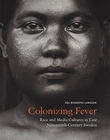Tyck till om SwePub Sök här!
onr:"swepub:oai:DiVA.org:uu-287650"
Sökning: onr:"swepub:oai:DiVA.org:uu-287650" > Colonizing Fever :
- 1 av 1
- Föregående post
- Nästa post
- Till träfflistan
Colonizing Fever : Race and Media Cultures in Late Nineteenth-Century Sweden
-
- Larsson, Åsa Bharathi, 1980- (författare)
- Uppsala universitet,Konstvetenskapliga institutionen
- Snickars, Pelle (preses)
-
- von Bonsdorff, Jan, professor (preses)
- Uppsala universitet,Konstvetenskapliga institutionen
- visa fler...
- Steorn, Patrik (opponent)
- visa färre...
- (creator_code:org_t)
- ISBN 9789198196160
- Lund : Mediehistoriskt arkiv, 2016
- Engelska 311 s.
- Serie: Mediehistoriskt arkiv, 1654-6601 ; 32
- Doktorsavhandling (övrigt vetenskapligt/konstnärligt)
Abstract
Ämnesord
Stäng
- The dissertation focuses on visual representations of the colonial world in late nineteenth-century Sweden. Situated at the intersection between postcolonial studies, visual culture studies and cultural histories of media, the study has a threefold aim. Firstly, it aims to draw attention to the presence of a colonial discourse in empirical material, the majority of which has not received attention before. Secondly, it analyzes these visual representations of the colonial world, in an expanding media culture in late nineteenth century. Thirdly, it explores how a mutual vision of the European colonial project and its civilizing mission was created via visual strategies and descriptions. The material comprises a wide range of media, visual arts, ephemera and illustrated press.“Part One: Race and Scientific Media – The Vanadis Expedition 1883–1885” analyzes the scientific Vanadis expedition of 1883–1885. I show how the expedition established a mutual vision of the European colonial project and its civilizing mission through its ambitions in trade, diplomatic relations and sciences. It was established in numerous media such as the press, travel journals, photography, illustrated press, photo albums, ephemera and visual arts. The ethnographical survey conducted measurements of the Indigenous populations and a racial photo archive was established.“Part Two: Race and Popular Media – Shows, Exhibitions and Attractions” analyzes contemporary entertainments such as the Wild West performances, ethnological exhibitions and wax displays. These acts, I argue, created a mutual vision of the European colonial project and its civilizing mission. For example, in the Wild West performances a narrative of life on the “last frontier” was seen as a fight for life between the White settler and the American Indian. In the ethnological exhibitions a mutual vision of the European colonial project and the civilizing mission was construed in the specific performances of the Indigenous people, which displayed a population on the “lowest ladder of civilization”. The Oriental Maze Salons differed from the above since they aimed to evoke fantasies of the Orient.“Conclusion” discusses the main results of the dissertation and proposes further research. The last part “Coda” reflects on contemporary postcolonial issues as related to nineteenth-century media cultures.
Ämnesord
- HUMANIORA -- Konst -- Konstvetenskap (hsv//swe)
- HUMANITIES -- Arts -- Art History (hsv//eng)
Nyckelord
- media cultures
- race
- late nineteenth century
- visual representations of the colonial world
- colonialism
- Sweden
- postcolonial theory
- urban everyday life
- scientific expeditions
- entertainment
- Konstvetenskap
- History of Art
Publikations- och innehållstyp
- vet (ämneskategori)
- dok (ämneskategori)
Hitta via bibliotek
- Colonizing Fever Race and Media Cultures in Late Nineteenth-Century Sweden (Sök publikationen i LIBRIS)
Till lärosätets databas
- 1 av 1
- Föregående post
- Nästa post
- Till träfflistan
Hitta mer i SwePub
- Av författaren/redakt...
- Larsson, Åsa Bha ...
- Snickars, Pelle
- von Bonsdorff, J ...
- Steorn, Patrik
- Om ämnet
-
- HUMANIORA
- HUMANIORA
- och Konst
- och Konstvetenskap
- Delar i serien
- Mediehistoriskt ...
- Av lärosätet
- Uppsala universitet
Sök utanför SwePub
- Sök vidare i:
- Google Book Search
- Google Scholar
Kungliga biblioteket hanterar dina personuppgifter i enlighet med EU:s dataskyddsförordning (2018), GDPR. Läs mer om hur det funkar här.
Så här hanterar KB dina uppgifter vid användning av denna tjänst.
- Copyright © LIBRIS - Nationella bibliotekssystem
- LIBRIS.kb.se

